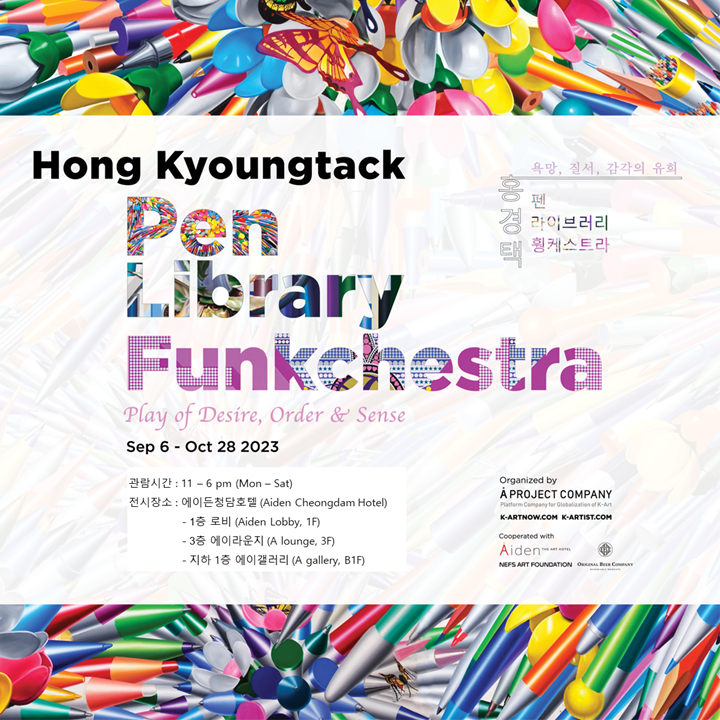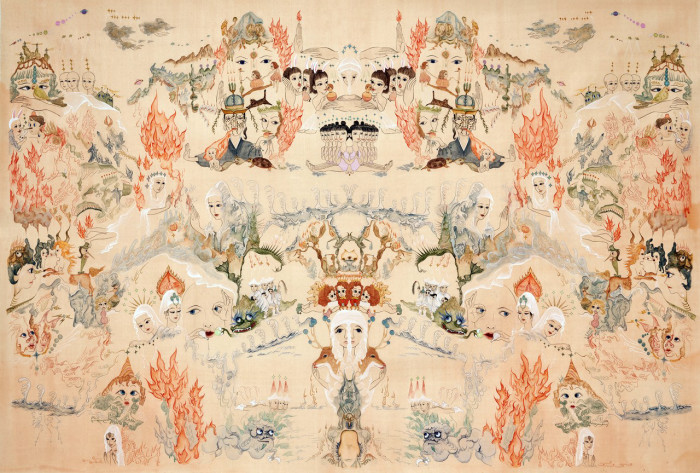The artist Hong Kyoung tack has demonstrated contemporary humans’ obsessive desire with specific objects such as pens, pencils, and books as well as diverse patterns. He has also introduced the Funkchestra series in which funk music and celebrities unite, questioning the difference between the spiritual and the popular, the intellectual and the uncultured in contemporary society. He has broadened the spectrum of his work from a series of his paintings and produced videos based on the series of his paintings. A number of art critics have interpreted his work in different ways. His showy colors, everyday objects, their patterns and movements filling the canvas, and narratives pertaining to celebrities having many elements to be interpreted from a diverse perspective, although his recent works are somewhat different.

반추 2, Reflection 2, 2013, Oil on linen, 200x200cm
First, there is a need to comment on the work titled Reflection. This painting depicting a patterned flower with golf clubs against a backdrop of space is very typical of his work. Noteworthy here is the word “reflection,” its title. The Reflection is carefully thought about appreciation of a particular subject. What did he look back on, appreciate, and ponder? Did he perhaps look back on his work full of overflowing energy and colors, the time he spent doing his work, and his inner transformation? The artist himself and his studio reflected onto the golf clubs can be grounds for this assumption.
This work discloses his presence and his studio space that has never appeared in his previous pieces, whether he intended this or included it by chance. We can assume this in his later presented works based on landscapes. The basic element of his recent pieces is not a daily subject matter or flashy colors typical of his previous work but landscape and quiet colors. In his previous work he concentrates on releasing his energy tirelessly through intense imageries in his previous work, but here he seems to look back upon the path he has taken.
 Installation view of "Green Green Grass"
Installation view of "Green Green Grass"Before looking into his new work, we need to explore his method. According to his personal disposition found in interviews and his own statements, he works as regularly as possible and usually doesn’t leave his studio unless necessary. To the artist, his studio is his own world or microcosm. Although it was probably unique in the past, many in contemporary society read, experience, and feel from their own space rather than having firsthand experience of the world. He does not seek experiences in the outside world. He rather seems to bring all things of the world into his space, thereby building up his own world. As such, the artist sees the world from the viewpoint of his everyday life. If so, what does the artist see and depict in his studio? The splendid images he portrayed before are nothing but moody illusions.
Although people are well aware that their lives will come to an end in the world they dream of, they try to conceal gloominess beneath splendor while their diverse desires collide and conflict as they proceed towards death. The images he illustrated are illusory, artificial things with incomparably showy surfaces. These images look like things that bring light and shadow together to the world, where we dwell like the sun, suggesting that everything in this world is filled with desires. As time slips by, objects have changed. In his work desire and death are always hidden under his work’s flamboyance and secretly and potently conveyed to us. His recent works featuring a golf course, the sky, the universe, and Mt. Everest seem to have nothing in common with his previous pieces. He presents landscapes as human dream and desire through this subject matter.
The golf course is usually a well-designed beautiful space, but it has nothing to do with ordinary life. Golf is still considered a luxurious sport in Korea and is thus the object of admiration for the general public. A golf course is also thought of as a place for business. Such desire and obsession is hidden in a beautiful landscape. If so, is nature different from man-made space? That’s not right in reality. Nature, such as high mountains, the sky and the universe, human’s gaze at in awe has always been scary, sacred, and mysterious. Inspiring human’s as being the source of legends and stories. However, this nature has degenerated into object of analysis, conquest, and desire for consumption. The physically inseparable sky is presently divided with imaginary lines. Many countries are competitively launching satellites. The scenes in Hong’s pieces are not romantic dreams any longer but things that have degenerated into objects of desire.
 Installation view of "Green Green Grass"
Installation view of "Green Green Grass"If so, why do people feel beauty and find solace not only in nature but also in artificial landscapes? Humans have a system of perception in which they classify, categorize, judge, and feel objects. The world is filled with things defined and managed by humans nature is no exception. We love man-made nature and landscapes we could admit and define. Nature outside of our perception and common sense is something indecent. We discover our desire, find solace, and purify our minds through all we define, manage, and control. We see objects with our physical eyes, not spiritual eyes, seeking a dream in reality. Contemporary people today enjoy material affluence but are in spiritual poverty. This devastated spirit is further paralyzed by sensuous pleasure. They are destined to this. We feel familiar to the artificial and comfortable with the honed.
To borrow his words, we can ask a paradoxical question “How can we accept nature as the object in which we can heal our hearts and take a rest without something artificial?” There is no space in the world humans cannot reach. Under these circumstance we long for nature less influenced by humans. Scenes are ironically imparted with meaning by humans whether they are artificial or natural, and they have their position as the object of rest and relaxation. Contemporary people feel stability, comfort, and peace within something visible people have made. Hong’s work makes us contemplate realistic scenes and surroundings.
Art is not so different from this. Art today has long pursued art for art’s sake, breaking away from emulating nature in reality. In the past, artists sought the essence of the world and tried to condense this into just one work of art. In the present however, the artists discover and collect essences dispersed everywhere, lending new meaning to the essences. They are now objectifying more things. Art could even perhaps degenerate into the object of desire and obsession in this process. This is probably because of the environment in which some hallmark only adopted in this world where all are judged by some specific measure and standard is required.
 서재-에베레스트산, Library-Mt. Everest, 2014, Acrylic and Oil on linen, 194 x 259cm
서재-에베레스트산, Library-Mt. Everest, 2014, Acrylic and Oil on linen, 194 x 259cmLet’s return to the exhibition title Green, Green Grass. As reviewed above, the title paradoxically refers to the environment full of desires through its emphatic repetition. If so, does he convey such narratives through landscapes unlike his previous pieces? In addition, no flashy colors and patterns are employed in his recent works. The artist meditates through these landscapes, using them to picture a perfect world humans could make and perceive. As ancient scholars in the East meditate on and relished imaginary space or places they hadn’t visited while viewing a landscape painting in their room, Hong draws all external things into his own space and encapsulate them in his paintings, seeing them as the objects of contemplation. He embraces them in his inner world through contemplation, relishing them in a way he didn’t in his previous work. His work circulates, not only radiating the internal but also bringing in the external. In this respect, we can discover some means for thought through painting in Hong’s work.
 Installation view of "Green Green Grass"
Installation view of "Green Green Grass"This is similar to how our ancestors tried to reach freedom while contemplating imaginary landscapes, escaping agonies in the mundane world. However, Oriental landscape painters escaped the real world for spiritual freedom, seeing nature as the underlying home of all and a haven from social confusion. In contrast, Hong does not deny reality to free him from the anguish of the world but faces reality, thereby looking back on himself. Hong’s scenes are the most realistic scenes approximating our idea and ideal. They are perhaps havens or the object of our thought and contemplation. His works on display at this exhibition display a combination of heterogeneous elements, patterns and natural scenery not found in his previous works. Therefore, we cannot define him as the artist who builds his own shrine only with his paranoiac inclination and maniacal obsession with collecting. He no longer stays in a fixed position as he proceeds to a new stage steadily.
Shin Seung Oh works as the director of Perigee Gallery, which is operated as a non-profit by KH Vatec, a leading company in advanced technology. Perigee Gallery hosts solo exhibitions of renowned Korean artists in their 40s through the series 〈Perigee Artist〉, supports exhibitions of emerging artists through 〈Perigee Unfold〉, and fosters collaborations between curators and artists via open calls in the 〈Perigee Team Project〉. Additionally, the gallery leads efforts to popularize contemporary art through its educational program for art enthusiasts, 〈Perigee Art School〉.


















